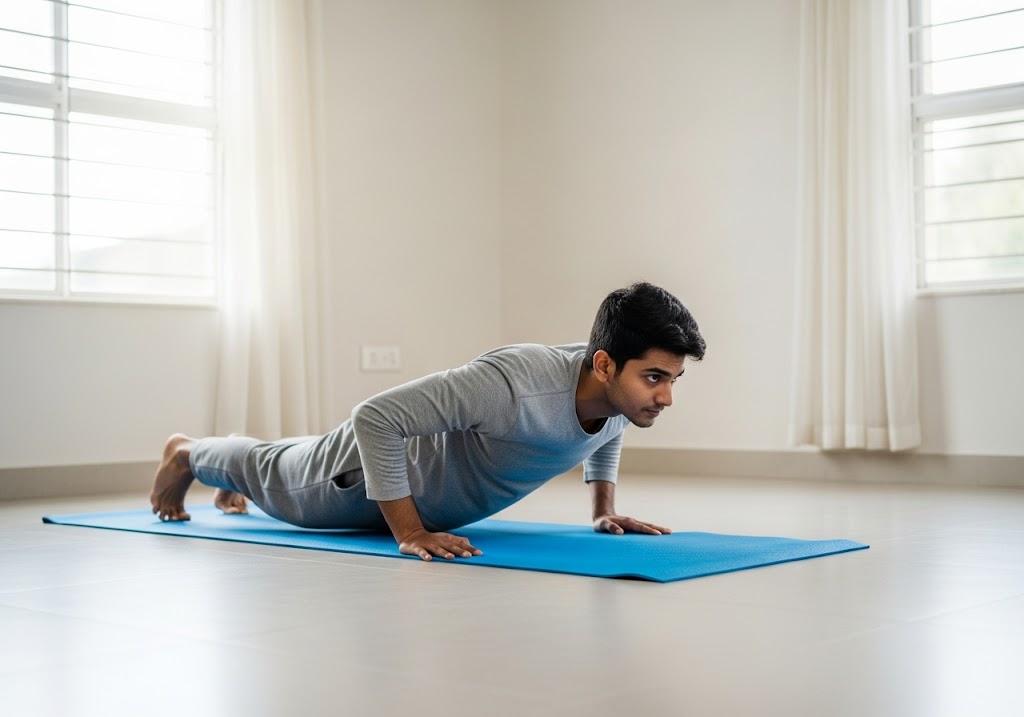Sit ups vs crunches comparison shows that sit-ups provide completecore training by engaging multiple muscle groups including hip flexors and burning more calories, while crunches offer safer, more targeted abdominal isolation with reduced injury risk and easier form mastery. Choose crunches if you’re a beginner or have back problems due to their lower risk profile, or select sit-ups if you’re advanced and want functional strength development with higher calorie expenditure for your core training routine. Key differences in sit ups vs crunches are: Range of motion (full vs partial), muscle activation (hip flexors vs isolated abs), difficulty level (harder vs easier), spinal movement (complete vs upper only), injury risk (higher vs lower), and calorie burn (more vs less).
Choosing between sit ups vs crunches can be confusing when both exercises target your abdominal muscles but offer different benefits and challenges. Sit-ups involve lifting your entire torso from the ground, engaging multiple muscle groups including hip flexors, while crunches focus on lifting just your shoulders and upper back, isolating the abdominal muscles more effectively. Understanding the sit ups vs crunches difference helps you select the right exercise for your fitness goals, whether you’re building core strength, reducing belly fat, or developing six-pack abs.
This complete comparison covers everything from proper form and muscle activation to safety considerations and effectiveness for different training goals. Whether you’re wondering which is better between crunches vs sit ups for beginners or advanced athletes, this analysis provides the insights needed to make informed decisions about your core training routine.
Table of Contents
Sit Ups vs Crunches: Which is Better?
Determining which exercise is superior in the sit ups vs crunches comparison depends on your fitness goals, experience level, and physical limitations. Both exercises offer unique advantages that make them suitable for different training contexts and individual needs.
| Comparison Factor | Sit-ups | Crunches | Winner |
|---|---|---|---|
| Beginner Suitability | Challenging | Easy to learn | Crunches |
| Advanced Training | Excellent challenge | Limited progression | Sit-ups |
| Safety Profile | Higher risk | Lower risk | Crunches |
| Muscle Activation | Full core + hip flexors | Isolated abs | Depends on goals |
| Functional Strength | Better carryover | Limited transfer | Sit-ups |
| Calorie Burn | Higher | Lower | Sit-ups |
| Joint Safety | Requires caution | Generally safe | Crunches |
| Equipment Needed | None | None | Tie |
| Learning Curve | Steeper | Gentler | Crunches |
| Injury Prevention | Needs proper form | Naturally safer | Crunches |
Learn how many calories 100 squats burn and how to use this simple move for weight loss.
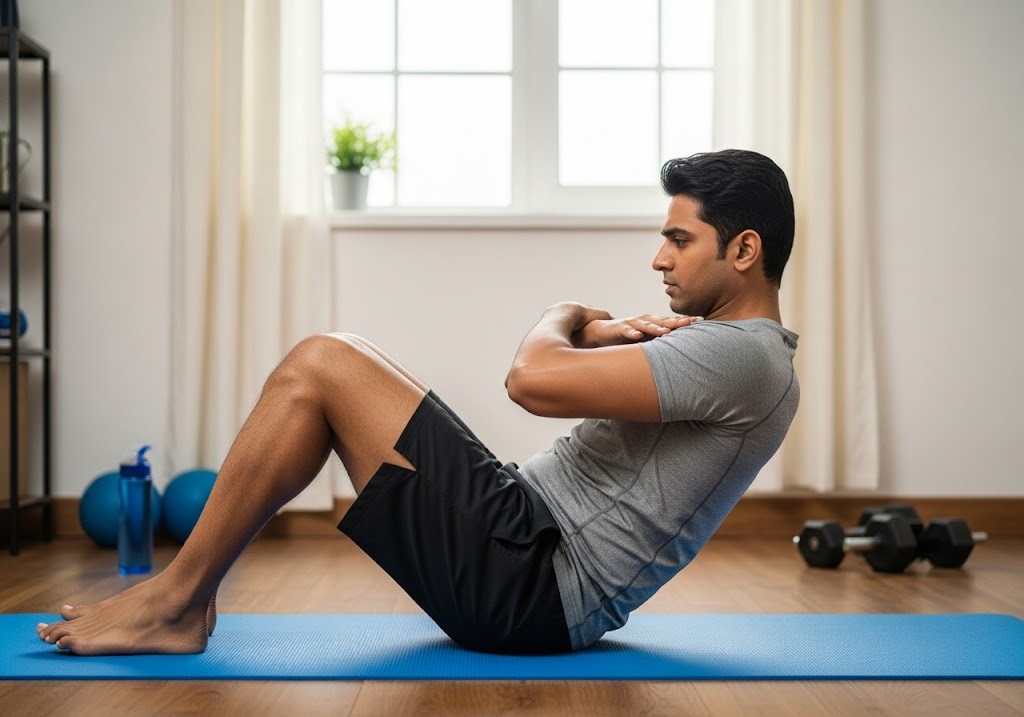
What are Sit-ups?
Sit-ups represent one of the most traditional abdominal exercises, involving lifting your entire torso from a lying position to create a complete range of motion. This exercise engages multiple muscle groups simultaneously, making it a compound movement that provides comprehensive core training benefits.
The primary muscles worked during sit-ups include the rectus abdominis, external obliques, and hip flexors, with secondary activation of the transverse abdominis and even some involvement from the neck and shoulder muscles. This multi-muscle engagement makes sit-ups effective for building functional core strength that transfers to daily activities and athletic movements.
However, the sit ups vs crunches debate often centers on safety concerns, as the full range of motion in sit-ups can place stress on the lower back and neck if performed with improper form. Many fitness professionals now recommend modified versions or alternative exercises for individuals with back problems or those new to core training.
See how many calories a plank burns and how to improve your core workout.
How to do a Sit-up?
Proper sit-up technique is crucial for maximizing benefits while minimizing injury risk in the ongoing sit ups vs crunches comparison for effective abdominal training.
Setup and Starting Position:
- Lie flat on your back with knees bent at 90 degrees
- Keep feet flat on the floor, hip-width apart
- Place hands behind your head with fingers interlaced (avoid pulling on neck)
- Engage your core muscles before beginning the movement
Execution Phase:
- Exhale and lift your torso up by contracting your abdominal muscles
- Continue until your chest nearly touches your knees
- Keep your lower back in contact with the floor as long as possible
- Pause briefly at the top position
Return Phase:
- Inhale and slowly lower your torso back to the starting position
- Control the descent to maintain muscle tension
- Don’t let your shoulders completely touch the ground between reps
- Maintain core engagement throughout the entire movement
For beginners starting their fitness journey, bodyweight exercises for beginners provides additional foundational movements that complement abdominal training. Understanding proper timing can also be crucial, so exploring is it better to do cardio before or after weights helps optimize workout structure.
Types of Sit-ups
Different sit-up variations offer unique challenges and target different aspects of core strength in the sit ups vs crunches discussion for comprehensive abdominal development.
- Decline Sit-ups: Performed on an inclined bench with feet secured higher than your head, increasing difficulty and resistance through gravity. This variation intensifies the challenge and provides greater muscle activation for advanced practitioners.
- Weighted Sit-ups: Add resistance by holding a weight plate or dumbbell against your chest during the movement. This progression increases strength-building potential and allows for measurable progression over time.
- Bicycle Sit-ups: Combine the traditional sit-up motion with alternating knee-to-elbow movements to engage the obliques more effectively. This variation adds rotational movement patterns that improve functional core strength.
- V-Sit-ups: Start and finish in a V-position with legs and torso elevated, creating an isometric hold component. This advanced variation challenges both strength and stability simultaneously.
Find the right balance with how many burpees a day to challenge yourself without burning out.
What are Crunches?
Crunches focus on the upper portion of the abdominal movement, involving lifting only the shoulders and upper back off the ground. This partial range of motion allows for better isolation of the rectus abdominis while reducing stress on the lower back and hip flexors compared to full sit-ups.
The primary advantage of crunches in the sit ups vs crunches comparison lies in their safety profile and accessibility for beginners. The reduced range of motion minimizes the risk of lower back strain while still providing effective abdominal muscle activation. This makes crunches suitable for individuals with back problems or those new to core training.
Research shows that crunches can effectively activate the upper rectus abdominis, though they may be less effective for the lower abdominal region compared to other exercises. The key to maximizing crunch effectiveness lies in proper form, controlled movement, and progressive overload through increased repetitions or added resistance.
Understanding proper recovery techniques such as what is foam rolling can help reduce muscle soreness and improve performance in your abdominal training routine. For those interested in advanced core development, calisthenics human flag demonstrates how core strength transfers to impressive bodyweight skills.
How to do a Crunch?
Mastering proper crunch technique ensures maximum abdominal activation while maintaining safety in your sit ups vs crunches training routine for optimal core development results.
Starting Position:
- Lie on your back with knees bent and feet flat on floor
- Place hands lightly behind your head or crossed over chest
- Keep your lower back pressed against the floor
- Engage core muscles before starting the movement
Movement Execution:
- Exhale and lift your shoulder blades off the ground
- Focus on bringing your ribcage toward your pelvis
- Keep your neck in neutral position (don’t pull with hands)
- Hold the peak contraction for 1-2 seconds
Return Movement:
- Inhale and slowly lower shoulders back toward the floor
- Don’t completely relax between repetitions
- Maintain constant tension in your abdominal muscles
- Control the movement throughout the entire range
For comprehensive core strength that supports crunch performance, how many planks should i do a day provides guidance on building foundational stability. Additionally, how many push ups to burn 100 calories offers insights into calorie-burning exercises that complement core training.
Types of Crunches
Various crunch modifications target different areas of the abdominals and provide progression options in the sit ups vs crunches selection for complete core training.
- Bicycle Crunches: Alternate bringing opposite elbow to knee while extending the other leg, combining crunch motion with rotation. This variation effectively targets both the rectus abdominis and obliques while improving coordination and adding cardiovascular challenge to the movement.
- Reverse Crunches: Lift your knees toward your chest while keeping your upper back on the ground, targeting the lower abdominal region. This variation helps balance out traditional crunches by emphasizing the often-neglected lower abs.
- Dead Bug Crunches: Extend opposite arm and leg while maintaining core stability, combining crunch motion with anti-extension training. This advanced variation builds functional core strength while improving coordination and stability.
- Cable Crunches: Use cable machine resistance to add variable load throughout the range of motion. This variation allows for progressive overload and increased resistance as strength improves.
For additional training methods that complement core work, resistance band workouts for men provides alternative approaches to abdominal strengthening. Those interested in holistic wellness approaches might also explore somatic pilates for mindful movement patterns.

Benefits: Sit Ups vs Crunches
Understanding the specific benefits in the sit ups vs crunches comparison helps determine which exercise better aligns with your fitness objectives and current capabilities. Both exercises target the rectus abdominis (the “six-pack” muscles) but through different ranges of motion and muscle activation patterns. Sit-ups provide a more comprehensive core workout by engaging additional muscle groups, while crunches offer more targeted abdominal isolation with reduced risk of lower back strain. The choice between these exercises depends on your fitness level, goals, and any existing injuries or limitations.
| Benefit Category | Sit-ups | Crunches | Better Choice |
|---|---|---|---|
| Muscle Activation | Full core + hip flexors | Isolated abs | Depends on goals |
| Calorie Burn | Higher | Lower | Sit-ups |
| Beginner Friendly | More challenging | Easier to learn | Crunches |
| Lower Back Safety | Higher risk | Lower risk | Crunches |
| Functional Strength | Better carryover | Limited transfer | Sit-ups |
| Equipment Needed | None | None | Tie |
| Time Efficiency | More muscles worked | Targeted focus | Sit-ups |
| Injury Prevention | Requires caution | Generally safer | Crunches |
For comprehensive core training that complements both exercises, exploring how to do plank exercise provides excellent stability training that supports abdominal development. Additionally, calisthenics for weight loss offers broader approaches to fitness that include effective core training methods.
Pros and Cons of Sit-Ups
Sit-ups remain one of the most recognizable core exercises, promising stronger abdominal muscles and improved fitness. However, this classic movement sparks considerable debate among fitness professionals. While sit-ups offer certain benefits for core strength and convenience, they also present potential risks and limitations that exercisers should carefully consider before incorporating them into their routine.
Pros of Sit-Ups: Sit-ups offer comprehensive core training by engaging multiple muscle groups simultaneously, providing better functional strength transfer to daily activities and sports. The compound nature of the movement burns more calories than isolation exercises while building strength in the hip flexors, which are important for walking, running, and jumping activities.
Cons of Sit-Ups: The full range of motion in sit-ups can place excessive stress on the lower back, particularly the lumbar spine, leading to potential injury risk. Many people perform sit-ups with poor form, pulling on their neck or using momentum rather than muscle control, which can cause neck strain and reduce exercise effectiveness.
Perfect your form and get maximum results with how to do bicycle crunches step by step.
| Aspect | Advantages | Disadvantages |
|---|---|---|
| Muscle Activation | Works multiple muscle groups | May overwork hip flexors |
| Calorie Burn | Higher energy expenditure | Not significantly higher |
| Functional Strength | Good carryover to activities | Limited sport specificity |
| Learning Curve | Familiar to most people | Easy to perform incorrectly |
| Equipment | No equipment needed | May need floor padding |
| Safety | Effective when done correctly | Higher injury risk potential |
For those concerned about back safety, should you exercise with sore muscles provides guidance on training safely when experiencing discomfort. Recovery considerations such as cold shower vs hot shower can also impact your training effectiveness.
Pros and Cons of Crunches
Crunches are among the most popular abdominal exercises, widely performed in gyms and home workouts worldwide. Despite their popularity, fitness experts remain divided on their effectiveness and safety. While crunches can target specific core muscles and offer accessibility benefits, they also carry potential drawbacks and limitations worth examining before practice.
Pros of Crunches: Crunches provide excellent isolation of the abdominal muscles with minimal involvement of the hip flexors, making them ideal for targeting the rectus abdominis specifically. The reduced range of motion decreases stress on the lower back and makes the exercise more accessible for beginners or those with back problems.
Cons of Crunches: The limited range of motion in crunches may not provide the same functional strength benefits as full sit-ups, and the exercise primarily targets the upper portion of the rectus abdominis. Some critics argue that crunches promote poor posture by reinforcing forward head position and rounded shoulders.
| Aspect | Advantages | Disadvantages |
|---|---|---|
| Safety Profile | Lower injury risk | Limited functional carryover |
| Muscle Isolation | Better ab isolation | Neglects other core muscles |
| Beginner Friendly | Easier to learn | May become boring quickly |
| Back Safety | Minimal back stress | Doesn’t strengthen full core |
| Form Control | Easier to maintain | Limited progression options |
| Accessibility | Suitable for most people | Less challenging for advanced |
For comprehensive training that addresses multiple fitness aspects, calisthenics for weight loss provides broader approaches to fitness development.
Sit Ups vs Crunches: Muscle Activation
Understanding muscle activation patterns is crucial for targeting specific areas effectively. Sit ups engage multiple muscle groups simultaneously, creating a compound movement that works your entire core, hip flexors, and even some back muscles. Crunches provide more isolated abdominal targeting, focusing primarily on the rectus abdominis while minimizing involvement from other muscle groups for precise strengthening.
| Aspect | Sit Ups | Crunches |
|---|---|---|
| Primary Muscles | Rectus abdominis, hip flexors, obliques | Rectus abdominis (upper portion) |
| Secondary Muscles | Lower back, chest, shoulders | Obliques (minimal) |
| Muscle Isolation | Low (compound movement) | High (isolated movement) |
| Hip Flexor Involvement | High | Minimal |
| Core Stabilization | Full core engagement | Upper core focus |
Compare upper-body moves: arnold press vs shoulder press to see which shoulder builder fits your goals
Sit Ups vs Crunches: Core Strength Development
Core strength development varies significantly between these exercises due to their different movement patterns and muscle recruitment. Sit ups build functional strength through full-range motion, enhancing overall core stability and power transfer between upper and lower body. Crunches excel at developing specific abdominal strength and endurance, particularly in the upper rectus abdominis, making them ideal for targeted muscle development.
| Aspect | Sit Ups | Crunches |
|---|---|---|
| Functional Strength | High (full body integration) | Moderate (isolated strength) |
| Core Stability | Excellent (dynamic stability) | Good (static stability) |
| Progressive Overload | Easier to add resistance | Limited progression options |
| Strength Transfer | High (athletic movements) | Low (specific to exercise) |
| Beginner Friendliness | Moderate to difficult | Easy to moderate |
Find the best pressing variation for chest and shoulders: arnold press vs dumbbell press
Sit Ups vs Crunches: Risk of Lower Back Strain
Lower back safety is a critical consideration when choosing core exercises, as improper form or excessive strain can lead to injury. Sit ups carry higher risk due to hip flexor dominance and spinal flexion under load, potentially causing compression and strain in the lumbar region. Crunches offer a safer alternative with controlled movement and reduced spinal stress when performed correctly.
| Aspect | Sit Ups | Crunches |
|---|---|---|
| Lower Back Stress | High | Low to moderate |
| Spinal Flexion | Full range (higher risk) | Controlled range (lower risk) |
| Hip Flexor Dominance | Common problem | Minimal issue |
| Form Requirements | Strict form essential | More forgiving |
| Injury Risk | Moderate to high | Low |
Curious about calorie burn during squats: how many calories do squats burn
Sit Ups vs Crunches: Range of Motion
Range of motion significantly impacts exercise effectiveness and muscle development patterns. Sit ups utilize complete spinal flexion from lying flat to sitting upright, engaging muscles through their full length and promoting flexibility. Crunches employ partial range of motion, focusing on the strongest portion of the abdominal contraction while minimizing stress on the spine and surrounding structures.
| Aspect | Sit Ups | Crunches |
|---|---|---|
| Movement Range | Full (180° hip flexion) | Partial (30-45° trunk flexion) |
| Spinal Mobility | Promotes flexibility | Limited flexibility gains |
| Time Under Tension | Variable throughout range | Peak tension focus |
| Joint Stress | Higher (full range stress) | Lower (limited range) |
| Muscle Lengthening | Complete stretch-contraction | Partial stretch-contraction |
Want to torch 500 calories daily: how to burn 500 calories a day – smart methods that fit your lifestyle
Sit Ups vs Crunches: Calorie Burn
Calorie expenditure differs between these exercises due to varying muscle mass involvement and exercise intensity. Sit ups typically burn more calories because they engage larger muscle groups and require greater energy output throughout the full-body movement. Crunches burn fewer calories per repetition but can be performed at higher frequencies, potentially offsetting the difference through increased volume and workout duration.
| Aspect | Sit Ups | Crunches |
|---|---|---|
| Calories per Rep | Higher (more muscle groups) | Lower (isolated movement) |
| Exercise Intensity | Moderate to high | Low to moderate |
| Workout Volume | Lower reps typically | Higher reps possible |
| EPOC Effect | Moderate | Low |
| Total Session Burn | Higher per time unit | Depends on volume |
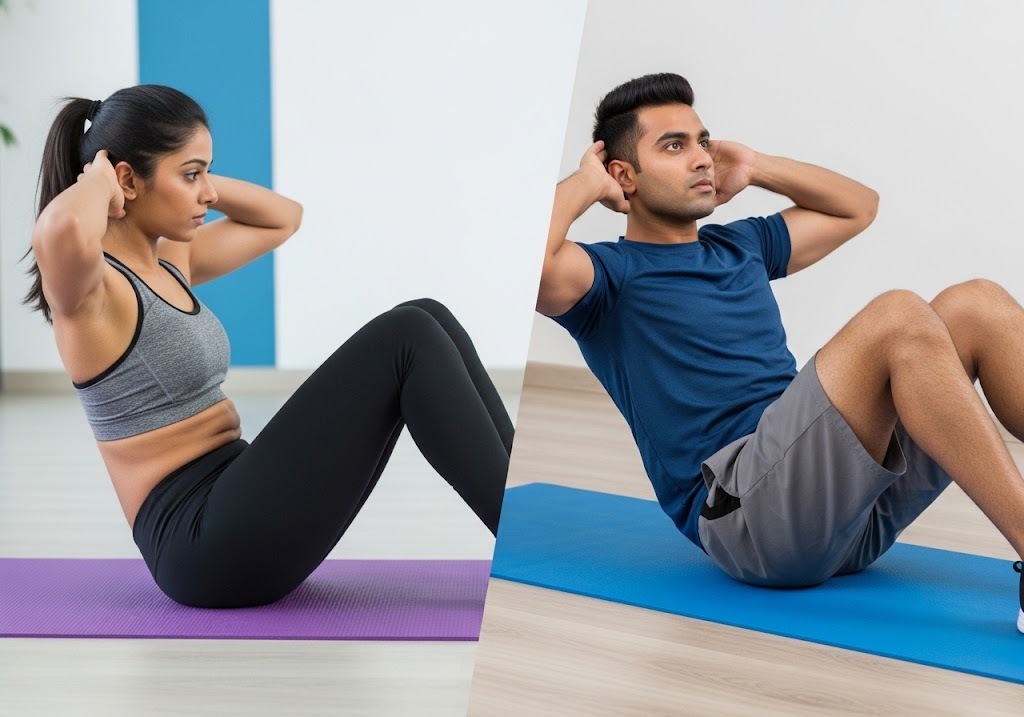
Sit Ups vs Crunches vs Planks
Expanding the comparison to include planks provides a more complete picture of core training options and their respective benefits for abdominal development. Planks offer isometric core training that builds stability and endurance without the spinal flexion involved in sit ups vs crunches movements. This static exercise engages the entire core musculature, including deep stabilizing muscles that dynamic exercises may not fully activate. Planks also carry minimal injury risk while providing excellent functional strength benefits.
| Exercise | Movement Type | Primary Benefit | Difficulty | Injury Risk |
|---|---|---|---|---|
| Sit-ups | Dynamic flexion | Functional strength | High | Moderate-High |
| Crunches | Partial flexion | Isolated abs | Low-Moderate | Low |
| Planks | Isometric hold | Core stability | Moderate | Very Low |
| Combination | All three types | Complete development | Variable | Low-Moderate |
The most effective approach often involves combining all three exercises to address different aspects of core strength and function. This comprehensive strategy ensures balanced development while minimizing the limitations of any single exercise choice.
For additional plank variations and progression ideas, how many planks should i do a day provides structured programming guidance.
What’s the Proper Way to Do a Crunch and a Sit-up?
Proper form is crucial when performing crunches and sit-ups to maximize effectiveness while minimizing injury risk. These fundamental abdominal exercises may seem straightforward, but subtle technique differences significantly impact results and safety. Understanding correct positioning, movement patterns, and common mistakes ensures you’ll target the right muscles while protecting your spine and neck.
Proper Sit-up Form
Correct sit-up execution requires attention to setup, movement quality, and breathing patterns for safe and effective abdominal training that maximizes muscle activation while protecting the spine.
- Position yourself with knees bent and feet flat on the floor
- Keep your hands behind your head without pulling on your neck
- Engage your core before starting the upward movement
- Lift your torso smoothly without using momentum or bouncing
- Exhale during the lifting phase and inhale during the lowering phase
- Control both the ascending and descending portions of the movement
- Stop when your chest approaches your knees, then lower with control
Explore tips and science-based methods in how to speed up muscle strain recovery for smarter recovery.
Proper Crunch Form
Effective crunch technique focuses on the quality of muscle contraction rather than range of motion, emphasizing control and precision for optimal abdominal development and safety.
- Lie with your back flat and knees bent at a comfortable angle
- Place hands lightly behind your head or across your chest
- Keep your chin slightly tucked throughout the entire movement
- Lift only your shoulder blades off the ground, not your entire back
- Focus on bringing your ribcage toward your pelvis
- Hold the peak contraction briefly before lowering slowly
- Maintain constant tension without relaxing completely between reps
For those starting their core training journey, how to start calisthenics provides foundational guidance for building strength safely.

Sit Ups vs Crunches Difference
Understanding the fundamental differences between these exercises helps optimize your core training strategy based on specific goals and capabilities. These distinctions affect everything from muscle activation patterns to injury risk and training effectiveness for different fitness levels.
| Difference Factor | Sit-ups | Crunches | Impact |
|---|---|---|---|
| Range of Motion | Complete torso lift | Shoulders only | Movement complexity |
| Muscle Engagement | Multi-muscle compound | Isolated abdominals | Training specificity |
| Hip Flexor Involvement | High activation | Minimal involvement | Movement pattern |
| Spinal Flexion | Full spine movement | Upper spine only | Safety consideration |
| Difficulty Level | Intermediate-Advanced | Beginner-friendly | Accessibility |
| Calorie Expenditure | Higher per rep | Lower per rep | Energy cost |
| Injury Risk | Moderate-High | Low | Safety profile |
| Equipment Needs | Floor space only | Floor space only | Convenience |
| Progression Options | Limited variations | Many modifications | Training variety |
| Functional Transfer | Better real-world | Limited application | Practical benefit |
For alternative approaches to core training, calisthenics at home no equipment provides equipment-free options for comprehensive fitness development. Understanding unilateral exercises can also add variety to your core training routine.
Full Sit Ups vs Crunches
Comparing full sit-ups to crunches highlights the trade-offs between comprehensive muscle engagement and targeted isolation in core training. This comparison helps determine which exercise better suits your training philosophy and physical capabilities for optimal results.
| Comparison Aspect | Full Sit-ups | Crunches | Key Consideration |
|---|---|---|---|
| Movement Range | Ground to upright | Shoulders off ground | Exercise complexity |
| Muscle Integration | Hip flexors + core | Core isolation | Training approach |
| Strength Requirements | High baseline needed | Accessible to all | Entry barrier |
| Flexibility Demands | Significant mobility | Minimal flexibility | Physical prerequisites |
| Calorie Burn Rate | Maximum expenditure | Moderate burning | Energy efficiency |
| Injury Potential | Higher risk profile | Lower risk factor | Safety priority |
| Repetition Capacity | Lower rep ranges | Higher rep potential | Volume capability |
| Functional Carryover | Excellent transfer | Limited application | Real-world benefit |
| Learning Curve | Steeper progression | Gentle introduction | Skill development |
| Training Sustainability | Requires recovery | Daily capability | Frequency potential |
For complementary exercises that enhance core strength, jumping jacks exercise benefits provides cardiovascular conditioning that supports overall fitness development. Additionally, considering nutritional support through intermittent fasting plan can enhance your core training results.
Abdominal Crunches vs Sit Ups
The distinction between abdominal crunches vs sit ups lies primarily in the range of motion and muscle activation patterns each exercise employs. This comparison reveals how exercise selection impacts training outcomes and safety considerations for core development.
| Training Factor | Abdominal Crunches | Sit-ups | Training Impact |
|---|---|---|---|
| Primary Focus | Rectus abdominis | Multiple muscle groups | Muscle targeting |
| Hip Flexor Role | Minimal involvement | Primary mover | Movement pattern |
| Spinal Stress | Reduced loading | Higher stress levels | Safety concern |
| Mind-Muscle Connection | Enhanced focus | Distributed attention | Training quality |
| Form Maintenance | Easier consistency | More challenging | Technique stability |
| Beginner Accessibility | Highly suitable | Requires progression | Entry level |
| Advanced Challenge | Limited difficulty | Natural progression | Skill development |
| Repetition Potential | High volume capable | Lower rep ranges | Training capacity |
| Joint Mobility | Minimal requirements | Flexibility demands | Physical prerequisites |
| Recovery Demands | Lower fatigue | Higher system stress | Training frequency |
For those interested in calorie-burning exercises, how many sit ups to burn 1000 calories provides detailed information about exercise energy expenditure.
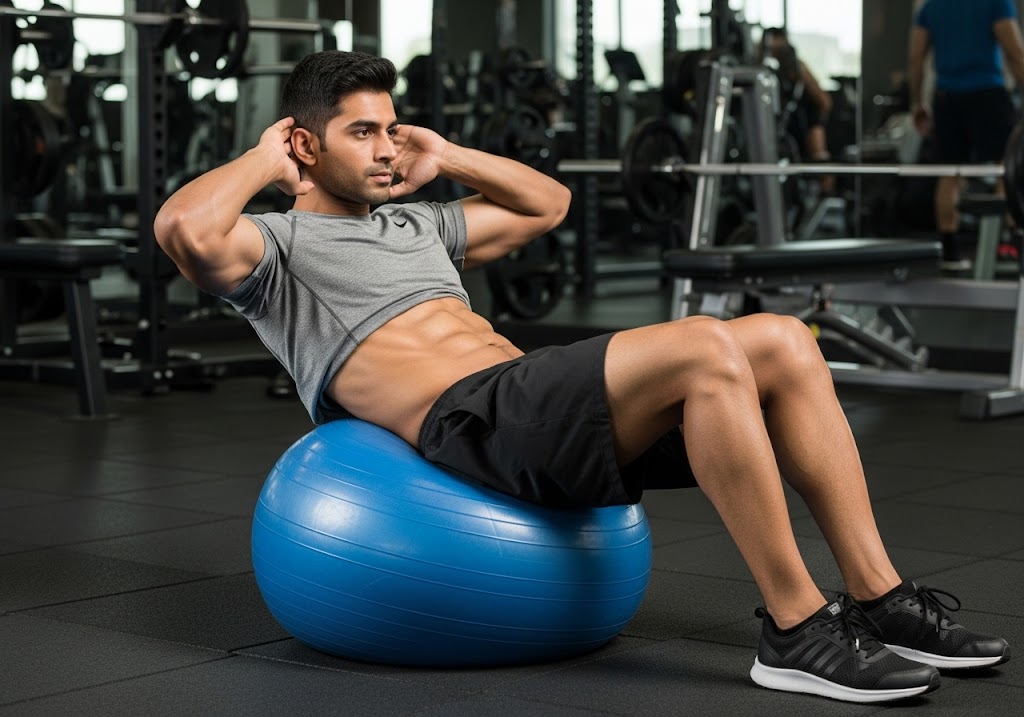
Bicycle Crunches vs Sit Ups
Bicycle crunches vs sit ups comparison reveals different approaches to abdominal training, with bicycle crunches adding rotational movement patterns to traditional flexion. This analysis helps determine which exercise better develops comprehensive core strength and coordination for athletic performance.
| Exercise Aspect | Bicycle Crunches | Sit-ups | Training Benefit |
|---|---|---|---|
| Movement Pattern | Rotation + flexion | Sagittal plane only | Movement diversity |
| Oblique Activation | High engagement | Limited involvement | Side muscle development |
| Coordination Demand | High complexity | Moderate requirement | Skill challenge |
| Cardiovascular Impact | Elevated heart rate | Moderate elevation | Metabolic benefit |
| Muscle Isolation | Core + obliques | Core + hip flexors | Targeting specificity |
| Exercise Variation | Many modifications | Limited variations | Training variety |
| Athletic Transfer | Rotational sports | Linear movements | Sport application |
| Balance Challenge | Dynamic stability | Static movement | Functional benefit |
| Learning Progression | Gradual complexity | Direct progression | Skill development |
| Training Volume | Moderate capacity | Higher potential | Workout density |
For comprehensive core training approaches, full body calisthenics workout provides integrated training methods that combine multiple movement patterns.
Which Exercise Burns More Calories?
In the sit ups vs crunches calorie-burning comparison, sit-ups generally burn more calories due to greater muscle mass involvement and larger range of motion. Sit-ups engage multiple muscle groups including the rectus abdominis, hip flexors, and stabilizing muscles throughout the core, requiring more energy expenditure per repetition. The full range of motion also demands more work against gravity, increasing the metabolic cost of each repetition. Additionally, the compound nature of sit-ups creates a higher heart rate response, contributing to increased calorie burn during and after exercise.
Crunches, while effective for muscle isolation, involve less muscle mass and a smaller range of motion, resulting in lower energy expenditure per repetition. However, crunches can often be performed for higher repetitions due to their lower difficulty, potentially closing the gap in total calorie burn for complete workout sessions.
For specific information about exercise energy expenditure, how many sit ups a day to lose belly fat provides detailed calculations and recommendations.
Sit-Ups vs Crunches: Drawbacks Comparison
While both sit-ups and crunches target core muscles, each exercise carries distinct disadvantages. Sit-ups involve greater spinal flexion and hip flexor engagement, potentially causing lower back strain. Crunches, though more isolated, can create neck tension and muscle imbalances when performed incorrectly or excessively.
Drawbacks Comparison Table
| Sit-Ups | Crunches |
|---|---|
| Higher injury risk – Full spinal flexion puts significant stress on lower back | Limited range of motion – Only works upper portion of rectus abdominis |
| Hip flexor dominance – Hip flexors often take over, reducing core activation | Neck strain – Tendency to pull on neck/head during movement |
| Spinal compression – Repeated flexion can compress spinal discs | Forward head posture – Can worsen existing postural problems |
| Lower back strain – Anchored feet create shearing forces on lumbar spine | Muscle imbalances – Overworks front core while neglecting back muscles |
| Poor for beginners – Requires significant core strength to perform safely | Plateau effect – Limited progression options compared to other exercises |
| Outdated technique – Many fitness professionals now discourage traditional sit-ups | Overuse potential – Easy to do too many, leading to muscle fatigue/strain |
| Joint stress – Can aggravate existing back or hip problems | Superficial results – Doesn’t engage deeper core stabilizing muscles effectively |
Dive into the facts with does jumping jacks reduce belly fat to find out how they fit into your fat-loss strategy.
Common Mistakes in Sit Ups vs Crunches
Avoiding common errors in both exercises ensures maximum benefit while minimizing injury risk in your core training routine. These mistakes often limit progress and effectiveness while potentially causing harm through poor movement patterns and technique execution.
- Sit-up Mistakes: The most frequent error involves pulling on the neck with interlaced hands, creating unnecessary stress on the cervical spine. Many people also use momentum rather than muscle control, bouncing off the ground to initiate movement instead of engaging the abdominal muscles properly. Another common mistake is performing the full range of motion too quickly, which reduces muscle tension and increases injury risk.
- Crunch Mistakes: Despite their apparent simplicity, crunches are often performed with excessive range of motion, turning them into partial sit-ups and increasing back stress. Many people also lose the mind-muscle connection by focusing on repetition count rather than muscle contraction quality. Holding breath during the exercise is another common error that reduces exercise effectiveness and can cause dizziness.
- Universal Mistakes: Both exercises suffer from poor breathing patterns, with many people holding their breath throughout the movement instead of coordinating breathing with muscle activation. Inconsistent form between repetitions and training too frequently without adequate recovery also limit progress and increase injury risk.
For proper warm-up techniques that prevent injury, warm up exercises for beginners provides essential preparation strategies.
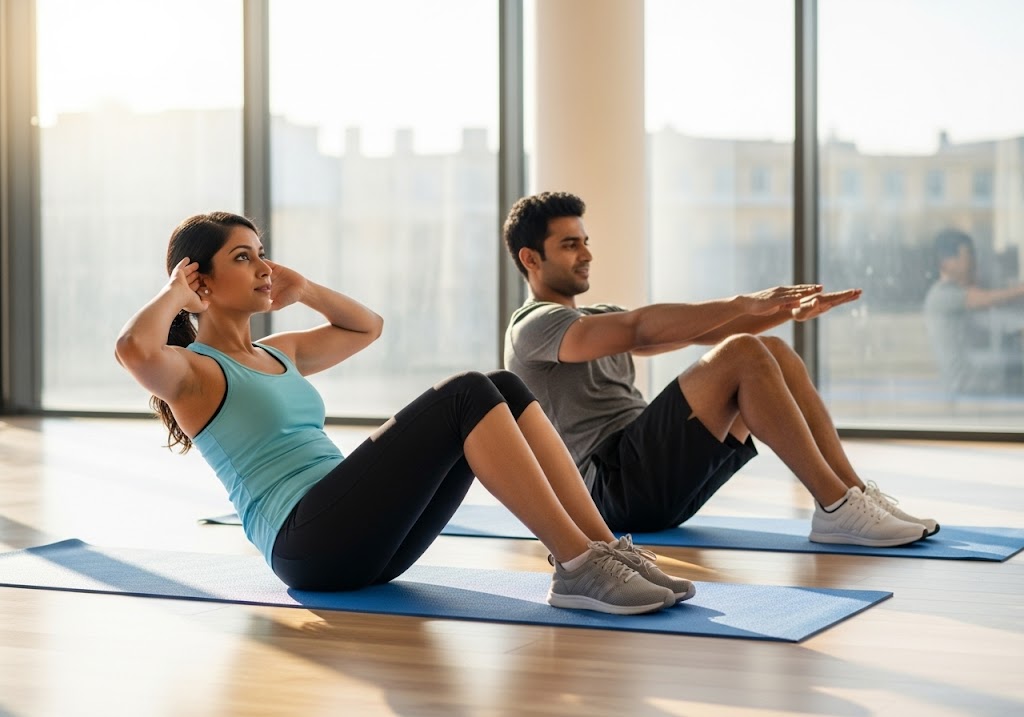
Best Alternatives to Sit Ups vs Crunches
While the sit ups vs crunches debate continues, several alternative exercises provide excellent core training with unique benefits and reduced injury risk. These options offer safer and more functional approaches to developing comprehensive core strength and stability.
- Plank Variations: Static holds that build deep core stability without spinal flexion, making them safer for individuals with back problems while providing excellent functional strength development. Planks also offer easy progression options through time increases and position modifications.
- Dead Bugs: Combine core stability with limb movement coordination, teaching proper core bracing while moving arms and legs independently. This exercise builds the type of core control needed for real-world activities and athletic performance.
- Mountain Climbers: Provide dynamic core training with cardiovascular benefits, combining core stability with metabolic conditioning. The alternating leg movement challenges anti-rotation strength while elevating heart rate for increased calorie burn.
- Hanging Leg Raises: Target the lower abdominals more effectively than traditional crunches while building grip strength and upper body stability. This exercise requires minimal equipment and provides clear progression markers through range of motion improvements.
For advanced core training progressions, calisthenics planche demonstrates how core strength transfers to impressive bodyweight skills.
Programming Sit Ups vs Crunches for Results
Effective programming strategies maximize the benefits of both exercises while preventing overuse and maintaining progressive development. Strategic planning ensures optimal results while accommodating different fitness levels and training goals for sustainable core strength improvement.
| Training Level | Exercise Focus | Volume | Frequency | Progression Strategy |
|---|---|---|---|---|
| Beginner | Start with crunches | 2-3 sets x 10-15 reps | 3x per week | Form quality first |
| Early Intermediate | Add basic sit-ups | 3 sets x 12-20 reps | 3-4x per week | Increase repetitions |
| Intermediate | Both exercises | 3-4 sets x 15-25 reps | 4x per week | Add variations |
| Advanced | Complex variations | 4-5 sets x 20-30 reps | 4-5x per week | External resistance |
| Expert | Integrated training | Variable volume | Daily options | Sport-specific patterns |
For guidance on training frequency and recovery, does calisthenics build muscle provides insights into bodyweight training effectiveness.
Conclusion
The sit ups vs crunches debate ultimately comes down to individual goals, fitness level, and safety considerations. Sit-ups provide comprehensive core training with greater muscle activation and calorie burn, making them excellent for advanced practitioners seeking functional strength. Crunches offer safer, more accessible abdominal isolation that’s perfect for beginners or those with back concerns. The most effective approach often involves incorporating both exercises strategically, using crunches for focused abdominal development and sit-ups for comprehensive core strength. Whether you choose sit ups vs crunches or combine both exercises, consistent training with proper form remains the key to achieving your core strength and aesthetic goals.
See how many steps to burn 500 calories and smart ways to include more movement in your day.
Want to master the calisthenics handstand and take your skills to the next level? Whether you’re a beginner or pushing advanced skills, ISC – Indian School of Calisthenics offers expert guidance to help you master bodyweight training. Visit us at SRPF Ground, NH8, Goregaon (E), Mumbai – 400065. For class schedules, personalized coaching, or more details, call +91 77159 53218. Train smart, move better, and unlock your back strength with ISC.
Sit Ups vs Crunches – FAQs
Why are sit-ups no longer recommended?
Many fitness professionals avoid recommending sit-ups due to increased injury risk, particularly lower back strain from full spinal flexion and potential neck problems from improper form execution.
Will 100 crunches a day do anything?
Yes, 100 daily crunches can strengthen abdominal muscles and improve endurance, but visible abs require low body fat through proper diet and comprehensive training approach.
Do sit-ups burn belly fat?
Sit-ups burn calories and strengthen core muscles but cannot spot-reduce belly fat; overall fat loss requires caloric deficit through diet and full-body exercise programming.
How many crunches to burn 100 calories?
Approximately 500-600 crunches are needed to burn 100 calories, depending on body weight and exercise intensity, making them inefficient for primary calorie burning.
How many sit-ups per day?
Beginners should start with 20-30 sit-ups daily, while advanced practitioners can perform 100+ with proper form, allowing rest days for muscle recovery and growth.
Can I get abs with situps?
Sit-ups can strengthen abdominal muscles, but visible abs require low body fat percentage achieved through proper nutrition and comprehensive exercise programming including cardio.
Will 20 sit-ups a day tone my stomach?
Twenty daily sit-ups can improve muscle endurance and strength but won’t significantly tone stomach appearance without proper diet and higher training volume.
Do planks burn belly fat?
Planks burn calories and strengthen core muscles but cannot spot-reduce belly fat; they’re excellent for building stability and supporting overall fat loss efforts.
Which exercise burns the most belly fat?
No single exercise burns belly fat specifically; high-intensity full-body exercises combined with strength training and proper nutrition create optimal fat loss conditions.
Will crunches make my stomach flat?
Crunches strengthen abdominal muscles but won’t flatten stomach appearance without reducing overall body fat through caloric deficit and comprehensive training approach.

